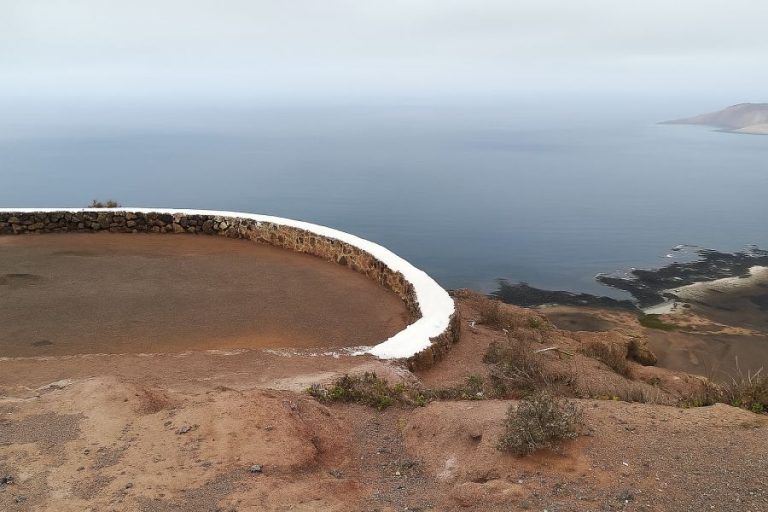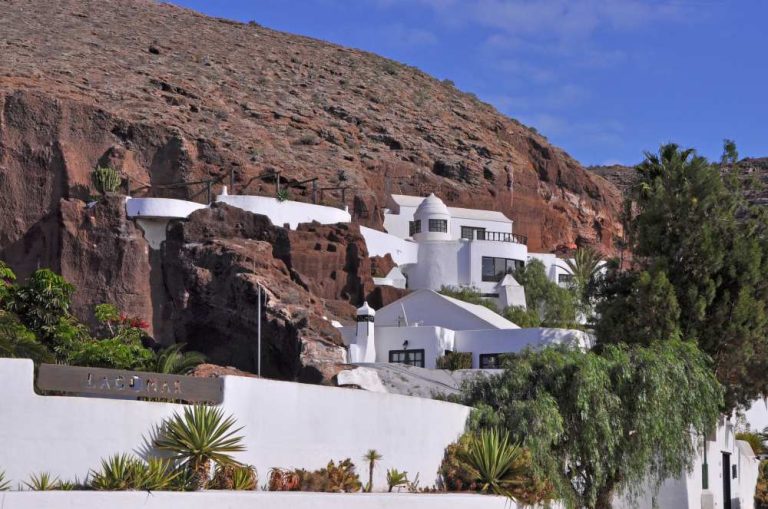Mirador Risco de Famara: how to get there, what to see and essential tips
If there is one place in Lanzarote capable of taking your breath away with the immensity of the landscape and the brute force of nature, it is undoubtedly the Risco de Famara viewpoint. Located in the north of the island, this natural enclave has become a must for those seeking unique panoramic views, tranquillity and a direct connection with the volcanic and oceanic environment of the Canary Islands.
To set foot on this viewpoint is not only to contemplate a good view; it is to face a breathtaking horizon, where the land seems to end in an abyss of cliffs that drop down to the Atlantic. I’ll tell you everything you need to know: from how to get there, what to see, practical tips and some of my own experiences.
Where is el Mirador de Famara?
Before putting on your boots or preparing your camera, it is important to locate this exact spot on the map of Lanzarote. The Mirador del Risco de Famara viewpoint is located in the municipality of Haría, in the north of the island. It is located in the area known as El Bosquecillo, a small natural park and recreational area that surprises by the contrast between its vegetation and the rest of the arid landscape of Lanzarote.
From an altitude of approximately 600 metres above sea level, visitors enjoy an unparalleled panoramic view of the Chinijo Archipelago, with the island of La Graciosa directly opposite, separated by the strait known as El Río. At your feet lies Famara Beach, with its characteristic arc of golden sand and eternal waves breaking on the shore. On clear days, you can also glimpse formations such as the Peñas del Chache, Lanzarote’s highest point, which reinforce the mountainous character of this region.

This enclave is far from crowded tourist routes, which gives it a more intimate and quiet atmosphere. A word of advice: if you are looking to disconnect from the noise and reconnect with the environment, you are on the right track here.
How to get to the Risco de Famara
Getting to this viewpoint is not difficult, but it requires attention to certain details that will make a difference in your experience. I will explain the most recommended routes depending on your means of transport.
Access by car
The most common way to get there is by car. From the village of Haría, take the LZ-10 road in the direction of Los Valles and then follow the signs to “El Bosquecillo” or the Mirador del Risco de Famara. In some sections, the road narrows and becomes steeper, so drive with caution, especially if there is fog or wind.
There is a small but limited parking area in the area. It is advisable to arrive early, especially in high season or if you hope to enjoy the sunset.

Access on foot or by bike (hiking)
The more adventurous choose to climb on foot or by mountain bike. The best known route is the Camino de los Gracioseros, a cobbled path that connects Famara with the viewpoint and was formerly used by the inhabitants of La Graciosa to reach Haría. This path also connects with the Bajo del Risco beach, famous for being one of the most pristine on the island. It is a tough but spectacular route, and only recommended for people used to demanding hikes and with good footwear. If you want you can rent bicycles in Caleta de Famara or on the beach.
Parking advice and precautions
If you decide to drive up, avoid parking in the unpaved areas. The wind can be strong at the top of the cliff, so dress appropriately even if the day looks sunny from the coast. And, of course, don’t look out too far– the cliffs are as beautiful as they are dangerous.
What to see from el Risco de Famara
As soon as you arrive and take the first step towards the cliff, you will realise that you are in front of one of the most impressive places in Lanzarote. The horizon seems infinite, and every metre gained towards the railing reveals a new layer of the landscape. I’m not exaggerating when I say that some of the best photos on the island are taken here.
Views towards Famara Beach and La Graciosa
From the top you have a perfect view of Famara Beach, with its characteristic curved arch and the surfers drawing lines in the water. The view continues to La Graciosa (but without a doubt the Mirador del Río is one of the best spots to contemplate this island), whose silhouette is clearly outlined on the horizon, together with the rest of the islets that make up the Chinijo Archipelago: Montaña Clara, Alegranza, Roque del Este and Roque del Oeste. You can also see the village of Caleta de Famara with its beautiful white houses typical of Lanzarote.
Famara Cliffs
The cliffs of Risco de Famara are the highest on the island, an authentic natural wall with a vertical drop of over 600 metres. On clear days, the sensation of vertigo is as real as it is addictive.
I have seen people get excited when they saw this landscape for the first time.
Sunset from the viewpoint
If you have the chance to stay until sunset, don’t hesitate. The sunset at the Risco de Famara viewpoint is simply magical. The light bathes the cliffs in golden tones, the shadows lengthen over the sea, and the silence becomes the protagonist. Only the wind and the sea breaking far below accompany you.
El Bosquecillo Park and its alternative lookout point
It’s not all rock and cliff. El Bosquecillo Park is one of the greenest areas in the north of Lanzarote. It has benches, picnic areas and a small children’s play area. It is ideal for a picnic before or after a visit to the viewpoint.

In this area is the Mirador del Bosquecillo, a small natural balcony carved out of the rock. It is not as high as the main viewpoint, but it has its charm. Many people confuse it with the Mirador Risco de Famara because of its proximity, although in reality they are two different points, both with excellent panoramic views.
The flora and fauna of this area are also an attraction. You can observe endemic plant species such as the verode, as well as birds of prey gliding over the cliffs, including the tagarote falcon.
The stone and the lookout cave: Where are they located?
One of the most sought-after elements for visitors to this area is the famous “viewpoint stone”, a large slab that juts out into the void and from where many travellers take photographs with the abyss in the background. It is not signposted, but is located a few metres from the main path, after a short descent.
There is also a small natural cave, often overlooked by visitors, which was used by shepherds and graziers as a shelter during crossings. These small elements give the site an additional ethnographic value.

Tips for an enjoyable visit
I want to use this part to share with you some recommendations that only someone who has been there several times, even in changing weather conditions, would give you.
Best time of day
The best light is in the early morning and late afternoon. If you are a photographer, take a tripod and ND filters if you want to capture the misty atmosphere that sometimes settles on the ridge.
What to bring
- Warm clothes (even in summer)
- Comfortable footwear
- Water and some food if you plan to stay for a while.
- Camera or mobile phone with good lens
- Sunglasses (because of the reflection of the sea)
Photos and recommendations for Instagram or blogs
The hashtag #MiradorRiscoDeFamara is not as saturated as other places on the island, which gives added value to your photos. The images from the overhanging rock or the sunset with Famara Beach in the background are the most shared.
Are you up for a visit? The Risco de Famara viewpoint is not just a tourist attraction: it is a place of contemplation, of wind and rock, where the island is revealed in its purest and wildest form. If you go, take it easy. Take a deep breath. Look into the distance.
And don’t forget to take the souvenir, not the stone.
When is the best time to visit the Risco de Famara in Lanzarote?
The best time of the year to visit the Risco de Famara in Lanzarote depends on what you are looking for: good weather, less tourists or optimal photographic conditions. Here are the details:
☀️ Best general season: April to June and September to November
- 🌤️ Pleasant weather: mild temperatures (20 – 26 °C), mostly clear skies.
- Good visibility: less haze (dust in suspension) than in the middle of summer.
- 😌 Less mass tourism: especially in May and October.
- Spectacular sunsets: the viewpoint faces west and offers golden views towards Famara.
🚫 Avoid if you can:
- July and August:
- Very hot (over 30°C in high altitudes).
- Increased haze, which reduces visibility.
- High tourist influx.
- January and February:
- Although mild, these are the windiest months with the possibility of cloudy skies or occasional rain in high altitudes.
| Epoch | Valuation | Key notes |
|---|---|---|
| April – June | ⭐⭐⭐⭐⭐ | Ideal climate, light and tranquillity |
| Sept – Nov | ⭐⭐⭐⭐ | Excellent balance |
| Jul – Aug | ⭐⭐ | Very hot and touristic |
| Dec – Feb | ⭐⭐ | More wind, some rain |
Frequently asked questions about the Mirador
There are some common questions that often arise before planning a visit. Here I will answer them directly and based on experience.
About the author

Maike Famara
Director of Surf Famara. A free surfer from the 1970s, renowned in the Canary Islands, he has surfed on five continents (the entire South African coast, Western Australia, Indonesia, Peru, Chile, Puerto Rico, Panama, France, Portugal, Senegal, Morocco...) and has dedicated himself to teaching and developing new surfers since 1996! You can find him in San Juan or La Santa, where he remains connected to the ocean like the first day.








